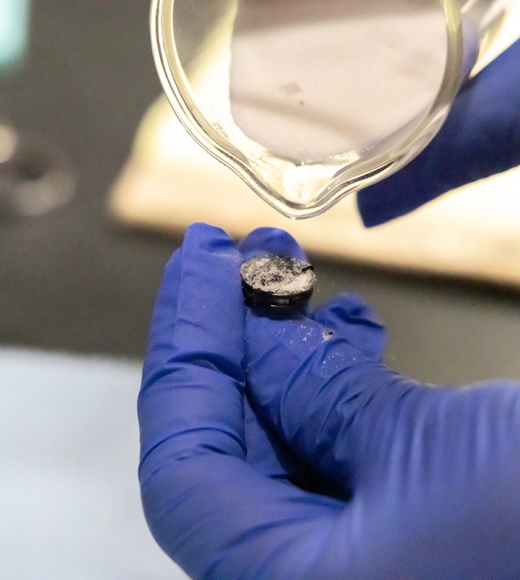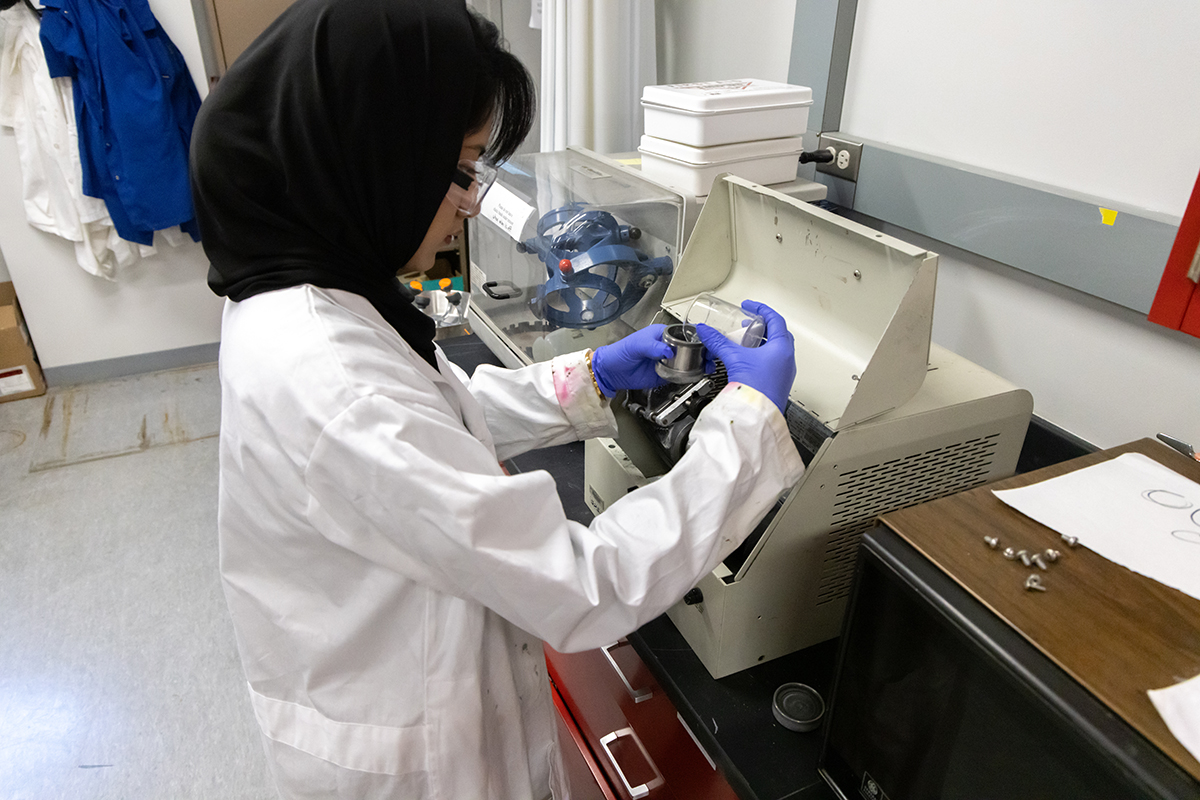Homerun Resources, Inc., mines silica quartz sand in Bahia, Brazil. Samples of the sand are sent to UC Davis for research into purification and creating high-grade silica carbide. (Courtesy of Homerun Resources, Inc.)
Disseminated on behalf of Zimtu Capital Corp.
By October 09, 2024
Materials science and engineering researchers at the University of California, Davis, and materials company Homerun Resources, Inc., have developed a groundbreaking one-step laser-pulse technique to purify raw silica sand to over 99.99% purity. The method is the first phase in a collaborative effort to create a pathway to a carbon-neutral process of deriving silicon from silica sand.

Silica Sand (Courtesy of Homerun Resources, Inc.)
The project began when Subhash Risbud, Distinguished Professor emeritus of materials science and engineering at UC Davis, was connected via a mutual friend with Brian Leeners, CEO of Canada-based materials company Homerun Resources.
Leeners needed someone to investigate purifying the raw silica sand the company was mining in Bahia, Brazil, using lasers as a potentially environmentally friendly purification method.
Risbud, who has a rich history of researching glass, much of which is made from silica, had used lasers in previous studies with quantum dot nanostructures and was interested in pursuing Leeners´ theory.
Arish Naim, a Ph.D. student in materials science and engineering, had recently come under Risbud´s mentorship and was eager to take on the project, drawn to its clean energy aspect. Risbud, Naim and Leeners developed a proposal for Homerun Resources, with Naim taking the lead on the experiments.
From Grains of Sand
First, the raw silica sand is homogenized, meaning all the particles are made the same size so that the heat is uniform when it´s applied to the sample. The sand is sealed in a vacuum and treated with lasers — at UC Davis, Naim uses the physics department´s laser at the Crocker Nuclear Laboratory — pulsed every femtosecond for different time periods between two and 24 hours. (The exact specifications are currently under patent review.)
Naim had also attempted thermal and furnace treatments with varying results, but when she was doing calculations on the data from the laser experiment´s X-ray fluorescence analysis, or XRF, she was stunned. After a couple of adjustments in the experimental parameters, the experiment resulted in over 99.99% purified silica.
"I turned to the person who does the XRF for me, and I was like, ´Do you think this looks like the right number?´ He said, ´Yeah, I think this is the right number,´" Naim said. "I was like, ´Are you serious?´ It was validating, it was exciting, it was all emotional. It was a remarkable day that I´ll never forget."
Risbud indicates that silica at this level of purity has a wide range of applications. Silicon wafers, for instance, are used in semiconductor devices, solar cells, LEDs, communication systems and the sensors in smartphones and medical imaging.

The experimental setup at the UC Davis Crocker Nuclear Laboratory, shown here, includes a laser pointed at silica sand in a clear tube. (Courtesy of Naim)

Naim coats the laser-treated silica sand on a scanning electron microscopy sample holder to characterize the processed silica sand. (Mario Rodriguez/UC Davis)
Purified silica can also be converted to silicon carbide, which is becoming increasingly sought-after in the semiconductor industry to replace silicon chips. Its ability to operate under extreme conditions makes it practical for electric vehicles, medical sensors, space exploration and renewable energy systems.
Leeners, who has been part of research and development in tech and materials science for 30 years, was amazed and pleased at the fast and desired result.
"Things never happen quickly, and your dreams rarely get fulfilled 100%, so to have Subhash and Arish come back and say, ´Yeah, we did the first test, and we got five nines,´ I was like, wow," he said. "We knew silica could achieve that, but we didn´t know if the laser could do that."
Building a Pathway to Cleaner Silicon
The team has goals to convert the purified silica into silicon carbide and then advance it to a high enough grade to use in anodes for lithium-ion batteries. Naim has spent the summer months at Lawrence Berkeley National Laboratory working on how to best go about the conversion to silicon carbide.

Ph.D. student in materials science and engineering Arish Naim is using ball mill equipment to grind the raw silica sand into a powder, which is the first step in the purification method. (Mario Rodriguez/UC Davis)

Arish Naim, pictured left, stands with Distinguished Professor Emeritus Subhash Risbud, who is advising her on devising a clean-energy strategy to purify silica and create silica carbide. (Mario Rodriguez/UC Davis)
"Purifying the silica was stage one," Naim said. "The end goal of this project is developing a value chain at the intersection of the battery and the mining industry to help in the clean energy transition in the U.S. This will be an advantage to the silicon industry, to the battery industry and to silicon metallurgy. It´s a holistic project."
Using clean energy to purify raw silica and generate battery-grade silicon carbide was one of the reasons lasers were considered in the first place, as opposed to the typical techniques.
"The idea is you take sand, which has impurities in it," Risbud said. "You heat it, and the impurities leave by evaporation. The normal way of doing this is chemical, which means you put some acid on it, leach it, wash it or do any number of steps in mineralogy and materials science."
The dream, said Leeners, is to develop a fully green processing technique so those chemicals — which are relatively safe and self-contained in the purifying process — aren´t even part of the equation.
"Theoretically you could have a solar energy generation facility creating the electricity that goes into the thermal processing done by lasers, which would then create silica that is recycled into creating more solar energy through silicon-based photovoltaics," he said. "It has the potential to be an elegant industrial cycle."
A Powerful Partnership
Naim and Risbud are working with Leeners on creating a similar pathway for taking silica quartz stone from British Columbia...
Read the rest of the article: https://engineering.ucdavis.edu/news/uc-davis-homerun-resources-innovate-carbon-neutral-path-laser-purified-silica
Previous Rockstone Reports
"Game-changer for Homerun to process its high-purity silica sand in hot sand batteries" (Web)
"Homerun in Bahia: At the forefront of one of the world‘s highest quality silica sand districts: Comparison of silica sand projects globally" (Web / PDF)
"The Energy Transition is Running Low on High-Purity Silica Sand: The Elephant in the Room" (Web / PDF)
Rockstone Disclaimer: The referenced external article and the mentioned Rockstone reports acontain forward-looking information or forward-looking statements (collectively "forward-looking information") within the meaning of applicable securities laws. Forward-looking information is typically identified by words such as: "believe", "expect", "anticipate", "intend", "estimate", "potentially" and similar expressions, or are those, which, by their nature, refer to future events. Rockstone Research, Homerun Resources Inc. and Zimtu Capital Corp. caution investors that any forward-looking information provided herein is not a guarantee of future results or performance, and that actual results may differ materially from those in forward-looking information as a result of various factors. The reader is referred to Homerun Resources Inc.´s public filings for a more complete discussion of such risk factors and their potential effects which may be accessed through its profile on SEDAR at www.sedarplus.ca. All statements in the Rockstone reports and the video interview, other than statements of historical fact should be considered forward-looking statements. Much of the Rockstone reports and video interview is comprised of statements of projection. Such statements involve known and unknown risks, uncertainties and other factors that may cause actual results or events to differ materially from those anticipated in these forward-looking statements. There can be no assurance that such statements will prove to be accurate, as actual results and future events could differ materially from those anticipated in such statements. Risks and uncertainties include that the proposed technology is not commercially viable and that the collaboration turns out fruitless; that Homerun will not find adequate buyers for this silica sand supply; uncertainty of future production, uncertain capital expenditures and other costs; financing and additional capital requirements for exploration, development, expansion of the mine may not be available at reasonable cost or at all; mineral grades and quantities on the project may not be as high as expected; samples found to date and historical drilling may not be indicative of any further potential on the properties; that mineralization encountered with sampling and drilling will be uneconomic; that the targeted prospects can not be reached; the receipt in a timely fashion of further permitting; legislative, political, social or economic developments in the jurisdictions in which Homerun or its partners carry on business may hinder progress; there may be no agreement with neighbors, partners or government on developing infrastructure; operating or technical difficulties or cost increases in connection with exploration and mining or development activities; the ability to keep key employees and operations financed; share prices of these companies may fall as a result of many factors, including those listed here and others listed in the companies’ and other mining exploration company disclosure; and the resource prices available when the resource is mined may not be sufficient to mine economically. Accordingly, readers should not place undue reliance on forward-looking information. Rockstone and the author of this report do not undertake any obligation to update any statements made in this report except as required by law. Please read the full disclaimer within the full research report as a PDF (here) as fundamental risks and conflicts of interest exist. The author of the Rockstone Reports, Stephan Bogner, owns an equity position in Homerun Resources Inc., and also owns equity of Zimtu Capital Corp., and thus will profit from volume and price appreciation of those stocks. The author is being paid by Zimtu Capital Corp. for the preparation, publication and distribution of this report, whereas Zimtu Capital Corp. also holds an equity position in Homerun Resources Inc. and thus will also profit from volume and price appreciation. Note that Homerun Resources Inc. currently does not pay Zimtu Capital Corp. but that the featured company has paid Zimtu Capital Corp. in the past for Rockstone reports and other investor awareness services.

